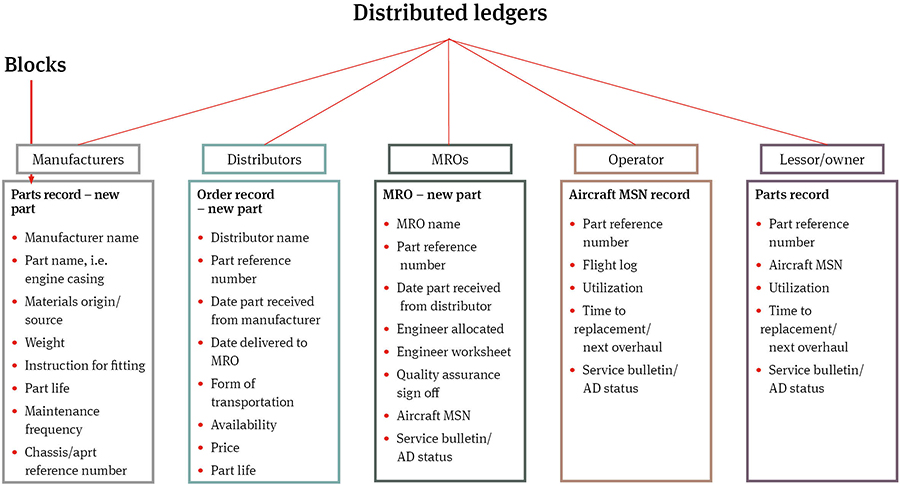The IT world recently became excited by a new technology, called blockchains or distributed ledgers. The underlying technology was invented in 2008 to support the creation of the electronic currency, Bitcoin. Since then, people have seen potential for many applications for this technology, particularly in information-intensive industries. Consequently, consortia in several industries have been announced, including banking (R3 Consortium), insurance (B3i), and aviation (BC4A, led by Lufthansa).
A shared or synchronized ledger is a shared database, fully replicated at multiple autonomous sites, and without anyone having central control. If any site wishes to update the database, it needs to follow an agreed multi-site decision-protocol. A blockchain is a special type of distributed ledger, where the data is collated into “blocks” before being added to the shared database, and the blocks combine to form a single sequential chain.
The excitement arises because distributed ledger technology (DLT) enables different organizations to share data in a database so that no one participant has control. Before DLT, database integrity would have only been possible by having a trusted third party control it. DLT ensures integrity by having a strict protocol for updating the database involving approval from the other participants.
Several different types of applications have emerged for DLT, including:
- Registers of identity information for people, organizations or objects. These apply for data used by multiple organizations, e.g., company identification documents, asset registers etc.
- Records of transactions as ownership or custody of assets changes. The company Everledger is using blockchains to register diamonds as they are mined, and to track their ownership and provenance over time.
- Cross-organization workflows. Because blockchain technologies enable creation and maintenance of shared data, they are particularly appropriate where multiple organizations have to work with common data, e.g., along supply chains, managing insurance, etc. The creation of a single view of shared data can eliminate the need for data reconciliation between participants.
- Promises and commitments. Because DLT records are effectively immutable, a natural application is to any domain where promises are made. In insurance, for instance, the insured promises to pay the insurer, who in turn agrees to pay out if a certain event happens (e.g., a fire).
For many of the above applications the tasks involved can be automated, and the respective computer programs could themselves sit on a blockchain. An example would be a program which automatically pre-orders new parts when parts reach their end-of-life. Such programs are called “smart contracts”, although they do not usually incorporate any artificial intelligence.
In aviation, there are several potential applications:
Passenger-focused and ticket sales
- Passenger identity information. Registering passenger identification information on a blockchain, for example, pertaining to passports and visas, may simplify an airline’s ability to comply with international security and visa requirements. Of course, there would need to be adequate provisions to ensure privacy and confidentiality.
- Passenger Loyalty Programs. A shared register amongst partners in a loyalty scheme would enable new partners to be added without additional complexity and facilitate the introduction of new and more redemption options for program members. The ability to seamlessly expand the scope of the loyalty offering would enable the program partners to be more agile and facilitate creation of tailored redemption offers based on known passenger trends and profiles.
- Blockchain registers of flights and tickets. Placing this data onto blockchains may facilitate re-scheduling and re-booking of flights for over-booked journeys, and thus promote resource efficiency. Having tickets on a blockchain could potentially support a legal secondary market in tickets, allowing passengers to on-sell tickets.
Aircraft ownership and financing
- Aircraft information. Creating a shared register of all aircraft would enable purchasers, lessors and financiers to quickly assess the provenance of the planes they are buying and track security over those aircraft, in particular where aircraft are being leased into numerous jurisdictions.
Cabin crew
- Registers of cabin crew by flight. Adding information about cabin crew to the registers of flights could better support the scheduling of training, simplify management of crew duty hours and positioning, as well as supporting sophisticated data analysis.
Aircraft parts and subsystems
- Parts tracking. With the widespread application of parts pooling both within an airline’s own fleet and as part of wider pooling programs, DLT would ease the burden on compliance with reporting requirements to lessors/owners in respect of the temporary and permanent replacement of parts. It may also simplify the management of a wider parts pool and provide users with a single point of information on availability and timings.
- Registers of aircraft sub-systems and parts, and their associated service histories. Although a much larger undertaking than a blockchain of only an aircraft as a whole, creating a blockchain register of all major parts and sub-systems would have many benefits for the industry. For example, it could allow maintenance, repair and overhaul organizations (MROs) access to the full operational history, parts history and specific configuration of an aircraft or engine from a single point. The usage and maintenance records of parts could also be uploaded and easily shared between all stakeholders – manufacturers, owners, lessors, lessees, maintenance organizations and regulators. In figure 1 below, we have identified what an aircraft parts blockchain might contain in terms of data.
If these blockchain registers were in place, then the automated scheduling of service checks and maintenance activities could also be facilitated, through the use of smart contracts. For example, the maintenance interval of certain parts can vary depending on the type of operation (e.g. high cycle, low hours) or operating environment (e.g. hot and harsh). A blockchain register combining parts installation, service history and utilization could not only support this automation for particular parts but this data could be used by an operator to optimize the serviceable life of such parts.
If such a collection of blockchains were in place, then other applications could easily present themselves. For instance, assessment of the provenance of specific aircraft and parts may greatly facilitate compliance with sanctions regulations.
Figure 1: Aircraft parts blockchain

Distributed ledger technologies still face many challenges before realizing their potential. Among these, the key technical issue is scalability. Initial use cases involve small numbers of transactions. This challenge will eventually be solved, although perhaps not for a decade. A second challenge concerns security and privacy. Blockchain was designed for a public system (Bitcoin) and its openness is inappropriate for applications internal to companies or between companies. Designing applications where the participants share only the data in common is still a design challenge for DLT projects. A final technical challenge is that the technology is still immature. Programming tools are inadequate, the technology still has constraints and the landscape is in flux.
There are also organizational challenges. Many use cases require collaboration between different organizations, e.g., along a supply chain. The first issue here is anti-collusion laws that exist in many countries. With appropriate legal advice, it is usually possible to collaborate without breaching these laws. A second organizational challenge is that of reaching stakeholder agreement. Even along a single supply chain, the companies involved may have conflicting interests, so designing a system to satisfy these interests can be difficult. The best approach is to start any DLT collaboration small, and to experiment with proofs-of-concept. Participants should first agree the goals of the collaboration, how any experiments will be evaluated, and the ownership of intellectual property.
Blockchain technologies have considerable potential in the aviation industry, with benefits in terms of greater efficiencies, new market and business opportunities, and easier regulatory compliance. Before benefits can be realized, significant technical and organizational challenges will have to be met through inter-company collaborations across the aviation industry. Undertaking these is an exciting prospect for anyone in the industry.







